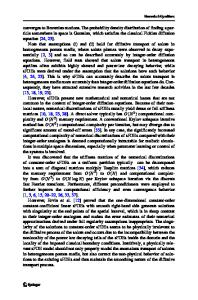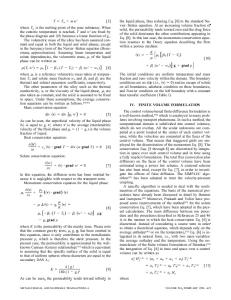A Parareal Finite Volume Method for Variable-Order Time-Fractional Diffusion Equations
- PDF / 959,802 Bytes
- 27 Pages / 439.37 x 666.142 pts Page_size
- 49 Downloads / 346 Views
A Parareal Finite Volume Method for Variable-Order Time-Fractional Diffusion Equations Huan Liu1 · Aijie Cheng1
· Hong Wang2
Received: 19 August 2019 / Revised: 15 June 2020 / Accepted: 21 September 2020 © Springer Science+Business Media, LLC, part of Springer Nature 2020
Abstract In this paper, we investigate the well-posedness and solution regularity of a variable-order time-fractional diffusion equation, which is often used to model the solute transport in complex porous media where the micro-structure of the porous media may changes over time. We show that the variable-order time-fractional diffusion equations have flexible abilities to eliminate the nonphysical singularity of the solutions to their constant-order analogues. We also present a finite volume approximation and provide its stability and convergence analysis in a weighted discrete norm. Furthermore, we develop an efficient parallel-in-time procedure to improve the computational efficiency of the variable-order time-fractional diffusion equations. Numerical experiments are performed to confirm the theoretical results and to demonstrate the effectiveness and efficiency of the parallel-in-time method. Keywords Time-fractional diffusion equation · Variable-order · Finite volume method · Parareal · Well-posedness
1 Introduction In the past decades, fractional partial differential equations (FPDEs) have been widely used in various scientific and engineering fields because of their powerful abilities to describe some challenging phenomena such as anomalous diffusive transport, long-range interaction and memory effect [18,19,25,33]. In most cases, analytical solutions to FPDEs were unavailable. Therefore many numerical methods have been developed, including finite difference methods [12,13,26], finite element methods [1,14], spectral methods [11] and so on. Error estimates in most of the literatures were derived by assuming that the true solutions to FPDEs
B
Aijie Cheng [email protected] Huan Liu [email protected] Hong Wang [email protected]
1
School of Mathematics, Shandong University, Jinan 250100, China
2
Department of Mathematics, University of South Carolina, Columbia, SC 29208, USA 0123456789().: V,-vol
123
19
Page 2 of 27
Journal of Scientific Computing
(2020) 85:19
have sufficient smoothness. However, it was gradually realized that the solutions to FPDEs exhibit nonphysical singularities near the initial time or on the spatial boundary, due to the incompatibility between the non-locality of fractional derivatives and the locality of initial and boundary conditions imposed on the FPDEs [2,24,28]. Recall that the classical diffusion equation was derived from the Fick’s law based on two common assumptions on the movement of diffusive particles, i.e., the existences of a mean free path (i.e., finite mean and variance) and a mean waiting time [18]. However, if we consider the solute transport in a highly heterogeneous porous medium with a large quantity of pores, the adsorbing effect between the particles and the porous matrix many cha
Data Loading...











